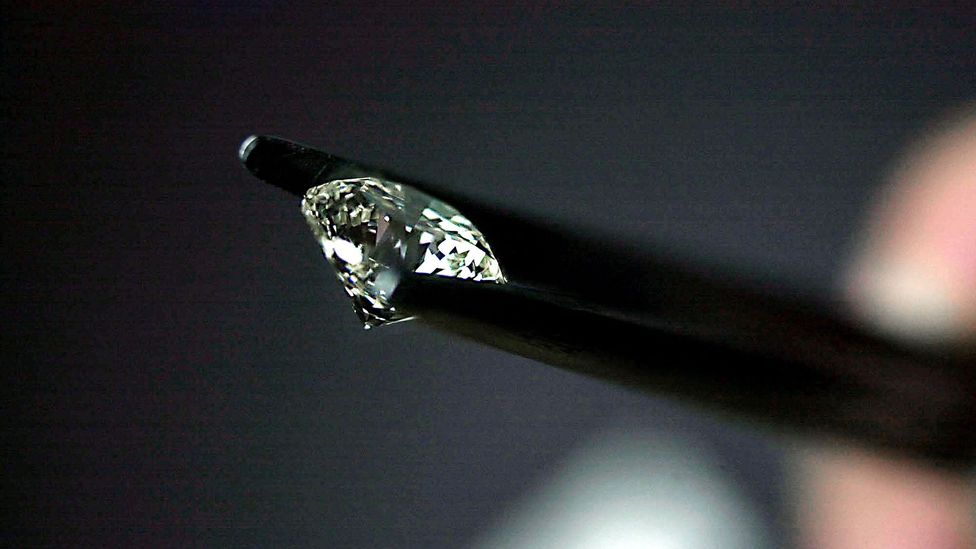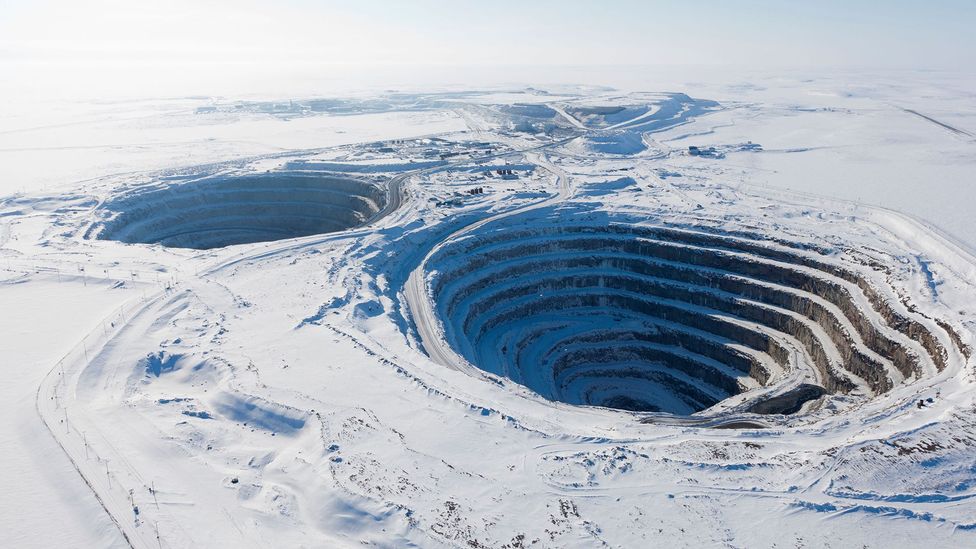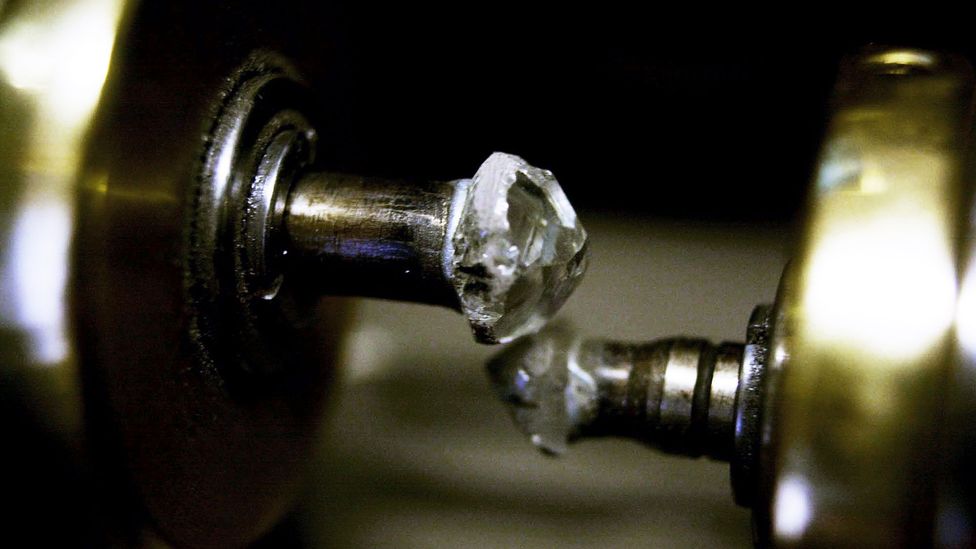Could You Make Money Buying Lab Grown Chinese Diamonds And Selling Them To Jewelers
The sparkling rise of the lab grown diamond
(Image credit:
Getty Images
)

Young people are falling out of love with mined diamonds because of their high ecology and humanitarian costs. How practice their alternative, lab-made diamonds, measure out upwardly?
O
On a grey January morning time in 2019 Meghan Markle emerged onto a London street on her way to a meeting. She wore a smart coat and heels, just information technology was not her clothing that caught the attention of the world. It was a pair of glittering driblet earrings embedded with diamonds that had been grown in a lab.
It took just v days to grow the diamonds adorning Markle'southward ears according to Sidney Neuhaus, co-founder of Kimaï, the company that made them. Based in Antwerp, the capital letter of the world's diamond business, both she and her co-founder Jessica Warch grew up in diamond families. Nauhaus's begetter owns a diamond jewellery shop, and her grandfather worked for De Beers, making his career in diamonds after World War Two.
Despite their illustrious family histories in the merchandise, Neuhaus and Warch chose to break away from conventional diamonds because of the ecology and humanitarian price of extracting them. Millennials and now Generation Z – who together are the main purchasers of diamonds for date rings – are moving away from conventional diamonds, with nearly seventy% of millennials considering buying a lab grown alternative. (Read more about the ascension of guilt free gems.)
Then what are lab grown diamonds, and are they really a more sustainable alternative to traditional mined diamonds?
Yous might also like:
• Can we heat buildings without fossil fuels?
• The quest to make a material harder than diamonds
• How does Future Planet count carbon?
First up, a lab-grown diamond is a diamond: chemically, physically and optically identical to a mined diamond. Naturally occurring diamonds are forged in the crushing pressure and immense heat of the Earth's mantle effectually 100 miles underground. Almost were formed between 1bn and 3bn years agone at a time when our planet was hotter than it is today.

There is piffling to differentiate lab grown diamonds from those that occur naturally other than the way they are made (Credit: Getty Images)
Lab-grown diamonds are also created using farthermost pressure and heat, but within a auto rather than the bowels of the Earth.
In that location are two means to grow a diamond. Both involve starting with the "seed" (a flat slither) of another diamond. The offset lab diamond was fabricated using a Loftier Force per unit area High Temperature (HPHT) system, where the seed is and so placed amidst some pure graphite carbon and exposed to temperatures of nearly 1,500C and pressurised to approximately 1.5 million pounds per square inch in a chamber.
More recently, another style to grow a diamond was discovered, called Chemical Vapor Deposition (CVD). This involves putting the seed in a sealed chamber filled with carbon-rich gas and heating to effectually 800C. Under these conditions the gases begin to "stick" to the seed, growing a diamond carbon atom past atom.
The technology behind lab diamonds has made crucial advances in contempo years, allowing companies to abound higher quality diamonds more than rapidly and more cheaply. It has meant growing competition between lab diamond and mined diamond companies. Today, it costs $300 to $500 per carat to produce a CVD lab-grown diamond, compared with $four,000 per carat in 2008, according to a study deputed by the Antwerp Earth Diamond Centre (AWDC).
Lab-grown diamonds are a chop-chop growing trend in the manufacture. Young diamond-buyers are drawn to them by price, transparency and for environmental reasons, with this segment of the market place increasing by between 15% and 20% annually, according to the AWDC report. The growth is expected to continue as more than jewellers start to sell lab diamonds and more than labs are launched.
Environmental credentials
But lab diamonds are not without error. A distinct lack of transparency makes it hard to source accurate data to compare the carbon footprints of mined and lab diamonds, but the energy needed to produce a lab diamond is pregnant. 1 written report on the topic, commissioned by the Diamond Producers Association, suggests that the greenhouse gas emissions produced mining natural diamonds is three times less than those created when growing diamonds in a lab. Information technology's worth noting that the DPA represents seven of the earth'due south largest diamond miners, including De Beers, Alrosa and Rio Tinto.

Extremely loftier temperatures are needed to grow diamonds in the laboratory, which uses a large amount of energy (Credit: Getty Images)
The figure is far less than that estimated by another consultancy Trucost, which produced the previously mentioned written report for the Diamond Producers Association. They put the carbon emissions from lab grown diamonds at 510kg CO2 per polished carat and those from mined diamonds at 160kg CO2 per polished carat.
Researchers at Anglo American, the parent visitor of De Beers, take also been working on a project to reduce the carbon footprint of mined diamonds past capturing carbon dioxide inside a porous mined rock known as kimberlite. Led by the visitor's geologist Evelyn Mervine, they have been developing a process called "mineral carbonation" as a style of off-setting the greenhouse emissions that come from the mining process.

Diamond mining tin involve the removal of vast amounts of earth and stone which creates holes and so big they can exist seen from space (Credit: Alamy)
Only the environmental harm from diamond mining goes further than simply its carbon emissions. Diamond mining has been linked to pollution of water sources used by local people due to acid mine drainage. This occurs when minerals from the mined rocks seep into the h2o supply. The University of Waterloo in Canada describes information technology as "1 of the mining industries top environmental liabilities". Although acrid mine drainage is not exclusively a problem for the diamond industry – it occurs at many metal and coal mines also – researchers at the University of Waterloo have been working with the Diavik diamond gem mine in Canada'due south Northwest Territories to reduce this pollution from waste rock.
Mining has as well caused the devastation of habitats in Canada and beyond. In 2016, The Wall Street Periodical reported that De Beers had killed over 18,000 fish draining a Canadian lake for diamond mining. In India, diamond mines accept been blamed for placing highly endangered tiger populations nether further force per unit area.
And then, while neither lab diamond nor mined diamond industries are perfect, the wider environmental price from the latter tin can be college. Indeed, the former Tiffany principal executive Michael J. Kowalski wrote in a 2015 New York Times opinion piece, "few industries in the world have a larger environmental and social footprint than mining".
Flawed origins
Indeed, the environmental and humanitarian harms from diamond mining are closely intertwined. Some diamond mines utilise miners on depression wages in unsafe conditions. Even diamonds extracted in accordance with the Kimberley Process, established in the early 2000s to reduce the trade in conflict diamonds, can have obscured origins. A source in the conflict resource team at the non-governmental organisation Global Witness, who wishes not to be named to protect their identity, says that there are many holes in the process. "The definition of a 'conflict diamond' as the Kimberley Process sees it is a diamond which is funding an armed grouping which is trying unseat a legitimate government," she says.
Over the years, the links betwixt mined diamonds and homo rights abuses have evolved far across that definition. "The Kimberley Process has failed to proceed up," she adds. She gives an instance of a huge discovery of diamonds in Zimbabwe in the mid-2000s that led to the deaths of hundreds of civilian miners. The diamonds institute here were traded in Antwerp and Dubai, "circulating freely on international markets", according to a Global Witness report.

Diamond mining provides employment in developing countries but is also surrounded by humanitarian concerns (Credit: Getty Images)
Farther down the supply concatenation, things get murkier even so, as once a stone is cut and polished it is no longer traced by the Kimberley Procedure. Diamonds pass through multiple trading hubs on their journey from mine to shop, and often end up mixed with diamonds from other countries of consign. The consequence is that fifty-fifty among diamonds with Kimberley Procedure certification, many companies cannot trace the diamonds they employ back to their state of origin. A 2018 report from Human Rights Scout, which investigated major jewellers including Buglari, Pandora, Cartier and Tiffany & Co, says, "None of the companies can identify all of their diamonds' individual mines of origin."
Merely there is as well business that the need for lab diamonds could have abroad jobs from resources-rich developing countries. Brad Brooks-Rubin, previous special counselor on conflict diamonds to the US Department of State and at present managing director at The Sentry/Enough Project, an organisation that aims to end mass atrocities in Africa's deadliest conflict zones, asks, "is information technology ethical to guide people away from ownership diamonds from developing countries, where a million people or more than rely on the work?"
Giving back
The humanitarian questions around lab and mined diamonds remain knotty, merely there is one way that lab diamonds come up out on top in terms of ecology impact. Diamonds for jewellery make up only 30% of the market, with the rest sold for use in drilling, cutting and grinding. It'south in this area that lab diamonds tin actually be used for environmental benefit.
One of their industrial uses is disinfecting polluted water sources. This is done by adding the mineral boron during the diamond-growing process to create a "boron-doped diamond", which is able to conduct electricity. By then applying current to the diamond information technology oxidises otherwise toxic organic compounds in a procedure called mineralisation, which turns them into a biodegradable form.
Jason Payne, chief executive of Ada Diamonds, argues that lab diamonds can too significantly reduce the carbon footprints in communications and send. The reason lab diamonds take the edge on mined diamonds here is down to their purity and hardness, with lab-grown diamonds found to be ten times more durable than natural diamonds.

Diamonds are among the hardest materials on the planet, which means the just mode to polish a rough diamond is with some other one (Credit: Getty Images)
"A diamond is the ultimate known semiconductor… far superior to silicon or other materials," says Payne. Using lab diamonds in transistors reduces the energy lost as estrus equally electricity is conducted from the power constitute to devices such as your mobile phone as it charges. The US Department of Energy reports that diamond-based components reduce these losses by up to 90%.
A thin coating of diamond has as well been shown to reduce friction in moving mechanical parts, from windmills to cars. Nissan reported a reduction in friction between engine parts of approximately forty% when using diamond film. In contrast with lab diamonds, mined diamonds "do not have the purity required for many of these applications," argues Payne.
The diamond illusion
In the past, when faced with existential threat, the mined diamond industry has advertised its style out of trouble. Indeed, the reason many of us are so addicted of diamonds stems from a clever advertising campaign launched by De Beers in 1947. The company forever changed culture when information technology convinced u.s.a. that "a diamond is forever", and that a diamond ring is a quintessential role of getting engaged. The idea that diamonds are rare is also a carefully crafted marketing illusion. In fact, excessive supply of diamonds has recently led to speculation that De Beers volition reduce its number of contracted buyers. The company has confirmed it will review the contracts of its rough diamond customers when they expire at the end of this yr.
But equally lab diamonds grow in popularity, the usual rebranding endeavour doesn't announced to be working for mined diamonds. The industry faces problems of oversupply and a slump in demand across the globe – particularly in China, the world'south 2d largest diamond market, where sales declined by 5% in 2019. At an industry meeting on the rooftop of a fancy London hotel at the end of November, Simon Forrester, chief executive of the Great britain's National Association of Jewellers told an audience that, "as an industry nosotros are suffering, [due to] lacking consumer confidence". The diamond behemoth De Beers recently announced information technology cutting production by 15% in tardily 2019 due to weak prices.

Demand for diamonds is declining in many parts of the world at a time when the industry has an oversupply of the gemstones (Credit: Getty Images)
Equally environmental sustainability and social welfare rising on consumers' agenda, Neuhaus says she has noticed a modify in atmosphere in Antwerp. "When I was younger [Antwerp was] super dynamic. Business organisation was flourishing for anybody. Now when I go back yous tin can feel there is another mood… in that location is less money than before," she says. Neuhaus's story of splitting abroad from her traditional family business into the more high-tech world of lab-grown diamonds is symbolic of this modify in the air. With clients like Meghan Markle on her books, her lab diamond business is thriving.
When information technology comes to jewellery, Neuhaus says that the real value in diamonds, mined or lab-grown, is non really most price or rarity. "It'southward more about the emotional value," she says, fingering a long gold necklace with a greenish pendant on it hanging around her neck. "This was the first piece of jewellery I made for myself." For this reason, every bit long as diamonds hold their emotional resonance, jewellers will continue to sell them, both lab-grown and mined.
--
Correction
This article has been amended as it originally stated that lab diamonds were x times harder than mined diamonds – in fact they are ten times more than durable. In addition, on diamond marketing campaigns, it has also been amended to state that the idea of diamonds being rare has been a advisedly crafted marketing illusion, rather than "rare and precious".
--
The emissions from travel information technology took to report this story were 0.7kg CO2, travelling by train, tube and bus. The digital emissions from this story are an estimated 1.2g to three.6g CO2 per page view. Find out more than about how we calculated this figure here.
--
Bring together one million Time to come fans past liking us on Facebook, or follow us on Twitter or Instagram.
If you liked this story, sign up for the weekly bbc.com features newsletter, called "The Essential List". A handpicked selection of stories from BBC Future, Culture, Worklife, and Travel, delivered to your inbox every Friday.
Source: https://www.bbc.com/future/article/20200207-the-sparkling-rise-of-the-lab-grown-diamond
Posted by: woodsterestand.blogspot.com

0 Response to "Could You Make Money Buying Lab Grown Chinese Diamonds And Selling Them To Jewelers"
Post a Comment